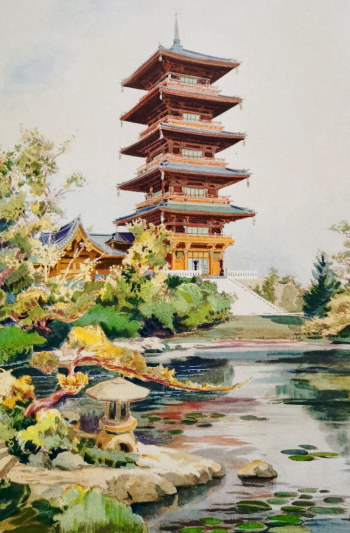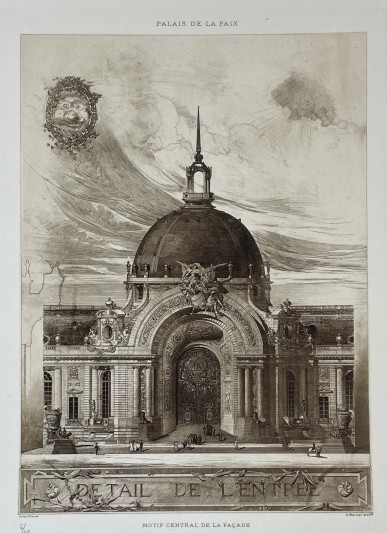Jonathan Ridsdale, Acquisitions Librarian, writes: This large folio contains 40 heliogravures, including 10 enhanced with watercolour, and 20 pages of specific information on the building projects; it is copy number six of only 110 produced. It is an important and very rare work showing design drawings, plans and elevations of realised buildings and proposed works by the early 20th-century French architect Alexandre Marcel heavily influenced by extensive study and research on indigenous Asian architecture.
Projects featured: La Tour et les Constructions Japonaises du Domaine Royal de Laeken (Belgique) (15 planches), Le Palais de Son Altesse le Maharajah de Kapurthala (Indes) (4 planches), Le Cambodge et sa Salle souterraine à l'Exposition Universelle de Paris en 1900 (7 planches), L'Hippodrome des Courses à Ostende (Belgique) (4 planches).
International competitions: Le Palais du Sénat à Bubarest (Roumanie) (2 planches), La Gare Centrale de Bucarest (Roumanie) (3 planches), Le Palais de la Paix, Fondation Carnégie à la Haye (Hollande) (4 planches), Les Grands Magazins modernes de Strasbourg (France) (1 planche).
The term Art Deco (actually invented in the late 1960s) is often used to describe the decorative arts and architecture of the 1920s and 1930s in Europe and the USA. Called Style moderne in its day, it should more accurately be applied to the style made popular by the Exposition Internationale des Arts Décoratifs et Industriels Moderne held in Paris in 1925 and therefore should relate to buildings and objects of French origin and those countries directly influenced by France. The exhibition was a government-sponsored project aimed at developing export markets for French decorative and applied arts, especially for luxury goods. Conceived in 1907, the exhibition was intended to take place in 1915 but was delayed because of World War I. Nevertheless, all the constituent elements of the Art Deco style were in place by 1914, combining elements of the French Art Nouveau, the elegance and refinement of the Austrian Wienerwerkstätte and the exoticism and strong vibrant colours of the Ballet Russes. Chinoiserie was an important element of the more exotic end of Art Deco design of this period, and this publication, a compilation likely put together for the 1925 exhibition, was an important contributor to the spread of orientalism at this period, particularly in relating it to contemporary architecture.
Alexandre Marcel (1860-1928) was a French-born architect based in Belgium who had become fascinated with Japonisme as the trade routes with Japan opened up in the latter part of the 19th century, and was one of the first to incorporate elements of orientalism into his work, such as the Pagoda Cinema (1896) and the Parc Oriental de Maulévrier (1899-1913), both Paris, and the Chinese Pavilion at Laeken, outside Brussels (1902), as well as the designs featured in this publication.

